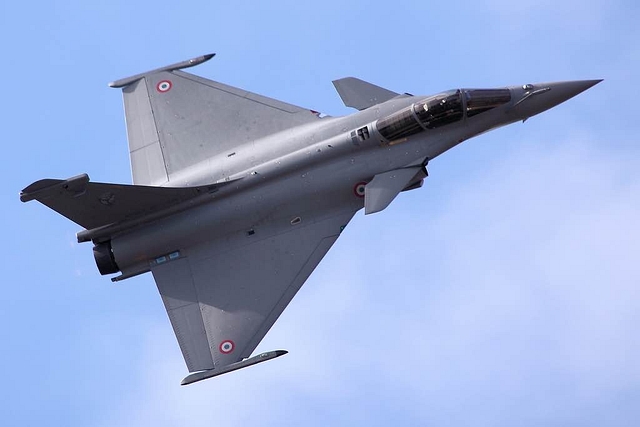
Rafale Deal: Are The Benefits Really Worth The Risks?
The decision to buy a small number of Rafale fighters off the shelf is shortsighted and exposes the air force to several long-term risks.
Ever since Prime Minister Modi announced on Friday that India would procure 36 French-made Dassault Rafale medium multirole combat aircraft (MMRCA) in flyaway condition, the digital and print media have been abuzz with observers either lauding or lambasting the government for its decision.
One of the arguments offered is that, this expedited purchase was essential to arrest the rapid decline of the Indian Air Force (IAF) fighter fleet. This reasoning is sound; however, there are concerns that while this decision will help in the short term, it will expose the IAF to excessive risk in the long run.
For one, the ‘urgent need’ argument pre-supposes that this is just an initial purchase; that it gives some breathing room to negotiators working out a deal to build an additional 108 aircraft in India under license. Considering how long these negotiations have dragged on until now, this expectation seems unjustifiably optimistic.
Saurabh Joshi of StratPost makes an excellent point when he asserts that the IAF is now effectively “locked in” to buy larger numbers of Rafales before the final price negotiations for the original MMRCA contract conclude. This will only hand Dassault the leverage to negotiate favourable terms for the remaining 108 aircraft, since India will be the entity with more to lose if things come unstuck.
Whether it is price or transfer-of-technology negotiations, the Indian side will be under immense pressure to agree to whatever terms Dassault proposes. Any disagreement that leads to a deadlock would see the IAF stuck with a mere two squadrons of Rafales – an ineffectual force no matter how capable each individual jet is, and more importantly, a logistical nightmare owing to minuscule numbers in service.
Other observers note that this announcement is akin to rewarding Dassault for dragging its feet on the negotiations. The message being sent to future vendors of Indian military equipment is quite clear – by stalling negotiations for local manufacture, they shall eventually be awarded with orders for direct deliveries to “urgently” bolster numbers.
This is exactly what happened a few years ago, when the Russians reneged on transfer-of-technology agreements for the T-90 main battle tank, and were awarded for their obstructionism with a ₹4,900 crore contract for an off-the-shelf delivery of 347 tanks. Russia continues to withhold key technologies from India till date, in spite of being paid the agree-upon price, with no penalties imposed on Rosoboron export for breach of contract. It is not hard to imagine that Dassault – knowing fully well that India’s hands would be tied after securing an agreement – would retain the option to similarly stonewall requests for timely technology transfer and walk away with a handsome profit at India’s expense.
This begs the question of whether the government overlooked other alternatives in the haste to procure the Rafale, and whether those alternatives could have mitigated the contractual risks associated with such a complicated procurement. Indeed, if the intention was to immediately plug the gap in IAF squadron strength, a further order for Sukhoi Su-30MKIs, possibility equipped with the Super-30 upgrade package, would have sufficed.
Another option would have been to purchase two or three squadrons of MiG-29 fighters, either as new builds or in the form of used airframes brought up to the UPG standard. If the Ministry of Defence were in a particularly creative mood, one could even make the case that the naval variant – the MiG-29K currently in service with the Indian Navy – would have been a suitable candidate for quickly boosting numbers.
Admittedly, the Rafale outclasses all these options when it comes to combat capability, especially in the crucial strike role in mountainous terrain.
Moreover, the problems plaguing the fleet of Russian-made alternatives mentioned above, from engine trouble to serviceability, would have been considered a major sticking point. These alternatives would nonetheless have had one crucial advantage going for them: commonality with the existing IAF fleet. Logistics and infrastructure considerations often trump aircraft performance when it comes to assessing their overall effectiveness within a force structure.
Therefore, the ability to plug into an existing system of logistical resources, base infrastructure, trained manpower, and a well-defined operational doctrine should have seen a “good enough” aircraft given preference over a highly capable counterpart for which these systems shall have to be built from the ground up. It is questionable whether the investment in time and money that will go into setting up a support system for a mere two squadrons of Rafales is justified given that the purchase is being touted as a stop-gap measure.
There is, however, one positive aspect to this decision that bears mentioning. The prime minister’s call represents a bold break from past acquisition practices – practices that prioritised avoiding outward appearances of corruption over timely arms acquisition; practices that mired practically every weapons acquisition program in red tape before stalling it altogether.
In the final analysis, a quick decision, even a sub-optimal one, is better than years of indecisiveness that sees things stuck perpetually in limbo. Over the longer term, the government would do well to use the same decisiveness to comprehensively overhaul the weapons procurement process. Otherwise, the MMRCA saga will keep repeating itself in one form or another, with long-term goals remaining unfulfilled and ad-hoc, reactionary acquisitions being used to tide over immediate deficiencies in military strength.